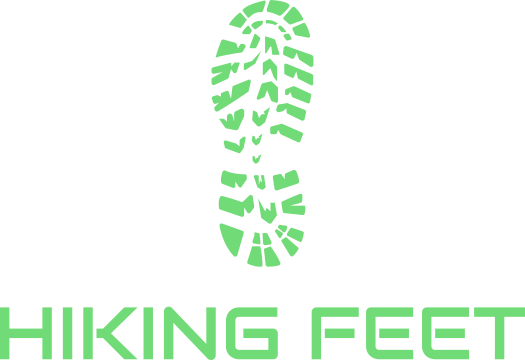Waterproof hiking boots may—or may not—be the best choice for your hikes. However, it's getting harder for hikers to make sense of their options with all the myths and misunderstandings about waterproofing and breathability that litter the internet. This post covers the basics on waterproofing and breathability to help hikers understand when they might choose waterproof hiking boots or non-waterproof options, especially non-waterproof trail running shoes.
waterproof hiking boots vs non-waterproof trail runners
Hikers have two reasonable options for keeping their hiking feet dry.
Waterproof hiking boots and (to a lesser extent) shoes usually work pretty well for most hikers. The best waterproof hiking boots have membranes that will seal out rain and snow while releasing evaporated moisture vapor. The tradeoffs are that waterproof footwear runs slightly warmer, traps in liquids if it gets swamped, and doesn't dry as quickly as lightweight footwear that's not waterproof.
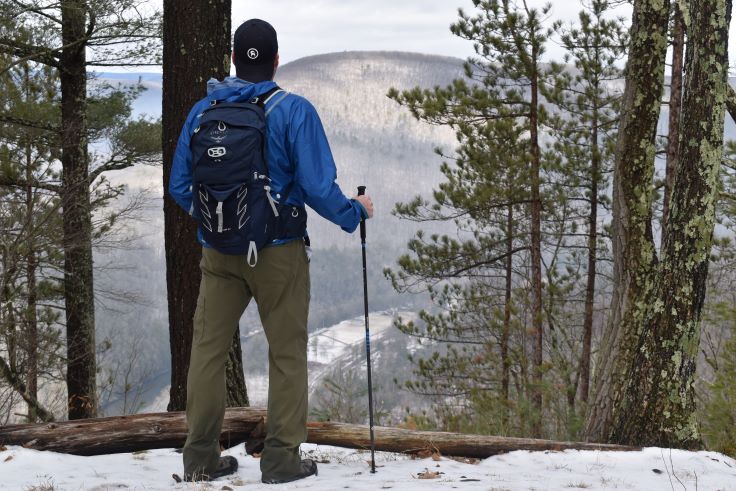
waterproof hiking boots are the obvious choice for cold and damp conditions
Those limitations have led some hikers—especially thru-hikers and ultralight backpackers—to pair non-waterproof trail running shoes with Merino blend socks that wick moisture and insulate while wet. Non-waterproof trail runners won't run as warm as waterproof hiking boots, and they'll dry faster than waterproof hiking boots if they do get swamped. The trade off is that it only takes a couple steps in a puddle or wet grass to soak hikers' feet in non-waterproof footwear.
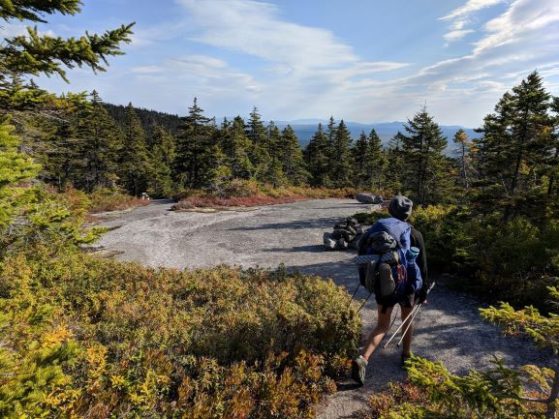
Thru-hikers often pair non-waterproof hiking shoes with merino blend socks
One rule of thumb is to determine if your feet are more likely to get swamped with outside moisture or inside moisture.
If you're more likely to get wet from rain, mud, wet vegetation, or snow, waterproof hiking boots usually make the most sense. For example, waterproof hiking boots are often the driest option for typical day hikes, wet fall or spring weather, winter hiking, and shallow water crossings.
However, if you're more likely to get swamped with sweat—or know your feet will get soaked no matter what—non-waterproof trail running shoes may be the lesser of two evils, due to their faster drying times. Non-waterproof footwear is often the better option for hot and humid environments, all-day hiking or backpacking, and deeper water crossings.
Many experienced hikers choose both. That is, they'll own waterproof hiking boots for winter and wet shoulder season hikes and non-waterpoof trail running shoes for hot summer hikes.
That's the short answer. The longer answer requires a sound understanding of waterproofing and breathability.
"waterproof" and "breathable" hiking footwear
As an outdoor industry professional, I know that many hikers are confused about waterproofing. And almost everyone mistakenly believes that “breathability" means the same thing as ventilation, air permeability, or moisture-wicking.
I did, too, until I started working in a hiking and backpacking shop. Thanks to my outdoor industry training, I now have a better understanding of waterproofing and breathabliity to pass along to hikers.
What is a "waterproof" hiking boot?
Waterproof hiking boots and shoes have a waterproof membrane inside of them that prevents water from leaking through under normal pressure. That's what makes them "waterproof"—not some spray or surface coating.
waterproof-breathable membranes
Waterproof membranes are thin sheets of water-tight material mounted INSIDE waterproof footwear to prevent water from leaking in. (They will also prevent liquids from leaking out.) Most waterproof membranes will be sandwiched between a protective backing and a lining or bootie that's visible inside your boot/shoe (see picture).
Waterproof membranes do NOT extend to the top of boots or shoes, which lets hikers slip their feet in and out. This only provides a few inches of water protection—just enough for some puddles and very shallow creek crossings. Waterproof footwear is not made to be fully submerged in water.
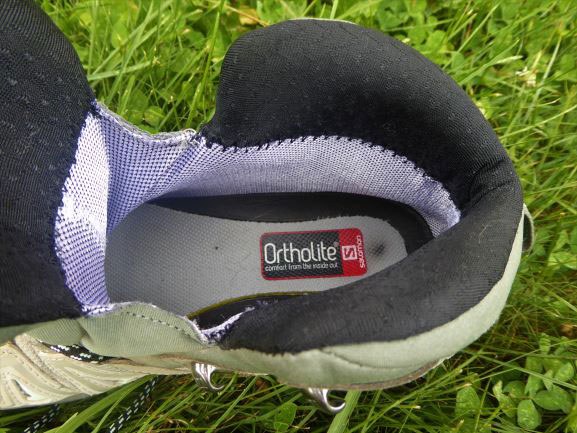
waterproof membranes are usually underneath a gray or silver lining
GORE-TEX remains the industry standard for durable and breathable waterproofing. GORE-TEX is a thin sheet of ePTFE (expanded polytetrafluoroethylene, aka Teflon)— and now ePE (expanded polyethylene)*—with 9 billion microscopic pores per square inch. Each pore is 20,000 times smaller than a single water droplet. That keeps liquid from seeping through the membrane (unless there's significant water pressure). At the same time, these microscopic pores are 700 times larger than chains of water vapor molecules in their gaseous state. This allows the membrane to "breathe"—to transmit evaporated water vapor to the atmosphere—when the heat and humidity are greater inside a boot/shoe than outside it.
* Between Fall 2022 and 2025, GORE-TEX is phasing out its traditional ePTFE membranes and replacing them with PFC-free GORE-TEX ePE for environmental reasons.
DWR: durable water repellent
Most brands also treat the surface of hiking boots and shoes with a durable water repellent, or DWR. DWRs do NOT create a watertight seal on the surface of a boot or shoe. They consist of microscopic spikes shaped in ways that help water bead up and run off your footwear. That DWR coating is there to (1) prevent moisture-wicking and (2) maintain the boot/shoe's breathability.
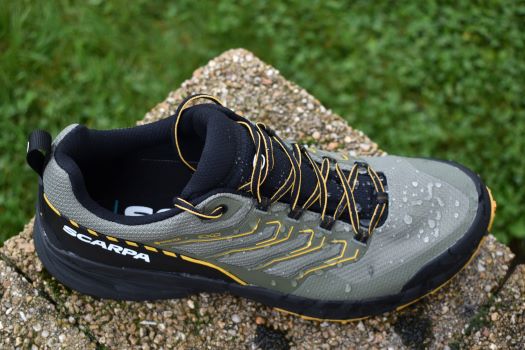
DWR coating causes water to bead up and run off the shoe
Like many things we own, durable water repellents require maintenance to keep working properly. That means (1) cleaning our footwear and (2) periodically re-applying DWR. This is especially true now that (good) brands have switched to PFC-free durable water repellents—which are not as bad for the environment but don't last as long.
When water stops beading off your boots/shoes, it's time to clean them and re-apply a durable water repellent. Nikwax and Grangers both make good products to restore water repellency—just select whichever DWR product matches your boot or shoe's uppers (e.g. synthetic/fabric, suede, nubuck leather, or full-grain leather).
It's easiest to buy a combo pack (cleaner + DWR) to restore a DWR coating:
- See Grangers Complete Footwear Kit (cleaner + DWR)
- See Nikwax Cleaner + DWR for suede/nubuck leather footwear
- See Nikwax Cleaner + DWR for leather and fabric footwear
However, you can also buy cleaners and DWRs separately:
Again, re-applying a DWR does NOT make footwear waterproof. However, it will limit moisture-wicking and maximize the breathability of our waterproof hiking boots and hiking shoes.
These are affliate links. If you click on these links and buy something, the retailer may share a small percentage of the sale with Hiking Feet. That doesn't cost you anything—and gives you an easy way to support this site's free and independent content.
Are hiking boots really waterproof?
Yes, waterproof membranes should prevent moderate to heavy moisture from seaping through your hiking boots and shoes. Most brands meet external standards for waterproof gear while GORE-TEX waterproofing is guaranteed for life.
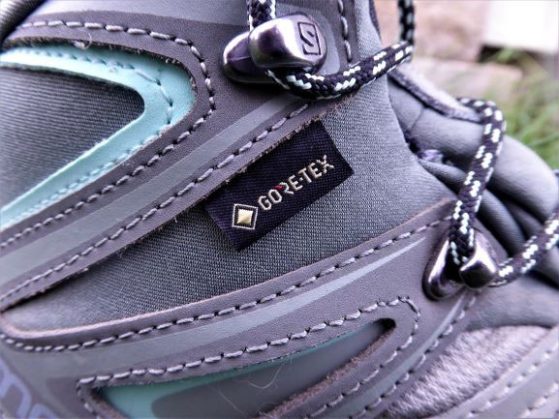
European brands can't call hiking boots "waterproof" without hydrostatic head tests that meet EU standards. Hydrostatic head tests measure how much water volume (in mm) or water pressure (in PSI) a membrane/laminate can hold for 24 hours before it leaks. The EU defines a 1,500mm water column as "water resistant" (not waterproof), a 5,000mm water column as "very waterproof," and a 10,000mm as "highly waterproof." These measures are proxies for moderate (5000mm) to heavy (10,000mm) rainfall.
US brands can set their own definitions of "water-resistant" vs. "waterproof." However, most good brands meet or exceed EU standards in order to export their products. For example, GORE-TEX has a hydrostatic head of at least 28,000mm—more than quintuple the EU's waterproof threshold—and conducts more active waterproofing tests that simulate hiking.
It's possible that sustained hikes on splashy or slushy trails can overwhelm a waterproof-breathable membrane after several hours. Even then, there's a decent chance that water worked its way in through moisture-wicking pants or socks—and never penetrated our footwear's waterproof membrane.
So, why do my feet get wet in waterproof hiking boots?
Hikers' feet usually get wet in waterproof hiking boots and shoes because
These are examples of hiker error more than waterproofing failure. In many cases, hikers can prevent (or significantly delay) wet feet by wearing waterproof pants or gaiters or restoring the DWR finish on their boots and shoes.
"There's no such thing as waterproof"
Many hikers and bloggers claim "there's no such thing as waterproof." However, most of their examples have nothing to do with water leaking through a waterproof membrane or laminate—which is what "waterproof" means.
If your feet get wet because rain runs down your legs or your hiking pants wick in moisture from wet vegetation, rain, or snow, that does NOT mean "hiking boots aren't really waterproof." Did water leak through the waterproof membrane? Nope. The failure point isn't the waterproofing—it's shorts or moisture-wicking hiking pants.
It's also hiker error—not a waterproofing failure—to flood waterproof hiking boots in a deep puddle or stream crossing. Waterproof boots and shoes are not made to be submerged fully since the waterproofing doesn't extend to the top.
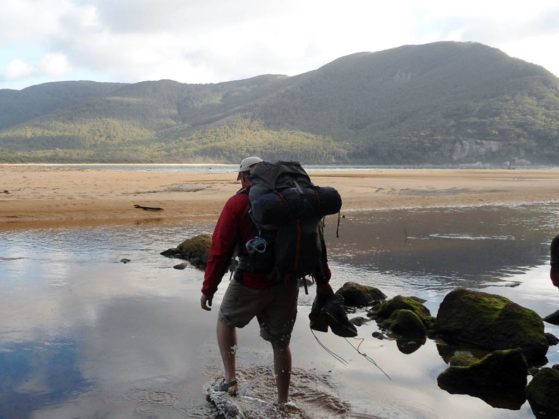
waterproof hiking boots are not made to be fully submerged in water
Others believe their waterproofing "fails" or "wears off" when water no longer beads up and runs off the surface of their waterproof hiking boots. But that coating is not the waterproofing—it's the DWR (which is easy to restore—see above).
Finally, many bloggers lead hikers to believe that their feet will get soaked with sweat because "waterproof hiking boots aren't breathable." With a smug tone, they'll predictably post something like this: "No matter what [marketers or GORE-TEX] claims, waterproof hiking boots aren't breathable because the waterproofing blocks airflow and prevents sweat and water from wicking out."
The problem is, breathability does NOT refer to air flowing through large pores or synthetic mesh to ventilate hikers' feet. Nor does breathability refer to wicking liquids to the outside air to evaporate.
What does "breathable" really mean?
According to reps from The North Face, Arc'teryx, and other leading brands, 99% of people use the word "breathability" incorrectly—including most outdoor gear websites. Almost everybody confuses breathability with air permeability or ventilation or (sometimes) moisture-wicking—when it's none of the above.
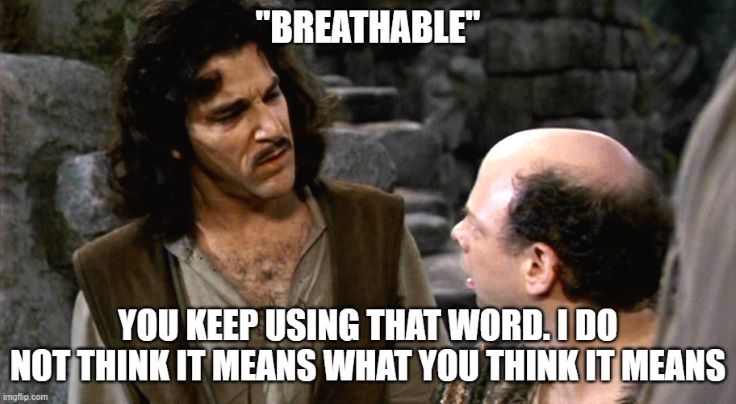
In the outdoor industry, "breathability" is a technical term for "moisture vapor transmission" or "evaporative transfer." It refers to water that's already evaporated—not to airflow (ventilation, air permeability) or liquids (water, sweat). Contrary to popular belief, breathability also has little to do with lightweight synthetic mesh.
Waterproof hiking boots transmit evaporated moisture vapor ("breathe") through their waterproof-breathable membranes when the heat and humidity are greater inside the boot than outside the boot. This works because warm, humid air naturally moves toward cooler, less humid air. It's this pressure differential, or heat and humidity differential, that effects evaporative transfer through seemingly solid materials, such as waterproof-breathable membranes.
Breathability mostly hinges on how much heat and moisture vapor hikers generate—based on their exertion levels, body chemistry, and the difficulty of their hikes—and on the heat and humidity in the outside air. Since breathability requires heat/humidity differentials, waterproof-breathable membranes work best
Breathability will be limited or non-existent
Waterproof hiking boots typically breathe pretty well because the air around our feet will be warmer and wetter than the atmosphere outside our boots and shoes. However, more extreme environments (e.g. jungles, coastal rain forests, Alaska) and high-exertion hikes (2,000 mile thru-hikes, 20 mile days) may expose the reduced breathability of waterproof hiking boots and shoes.
* The most uncomfortably warm I've ever been in a waterproof hiking boot has been walking around a store before/after a hike or wearing them casually around the house.
Are waterproof hiking boots really breathable?
Scientific testing shows that most waterproof hiking boots are breathable—in spite of what many bloggers claim (as they mix up breathability with ventilation, air permeability, and/or moisture-wicking).
Materials scientists, product engineers, and third-party labs measure breathability two ways. Some use tests that measure how many grams of evaporated water pass through a waterproof-breathable membrane over 24 hours. Some brands, such as GORE-TEX, measure Thermal Evaporative Resistance, or RET—how much materials restrict evaporated moisture from passing through them. The lower the RET rating (less resistance to evaporative transfer), the higher the breathability.
According to Jonathon Swegle—the engineer who tests all the boots and shoes that apply for GORE-TEX waterproofing*—upper materials (such as synthetic mesh) have little impact on breathability. Instead, it's a series of small design choices—such as tongue design, adhesive and insole materials, TPU overlays, etc.—that mostly determine how much heat and moisture vapor pass through a hiking boot and shoe, waterproof or not.
In his words, virtually all of today's hiking boots and shoes have breathable uppers. Synthetic mesh is breathable, but so is suede, nubuck leather, and (unless excessively treated) full-grain leather. (If you've ever seen steam rising off the back of a buffalo or cow in cool weather, you've witnessed the natural breathability of leather.)
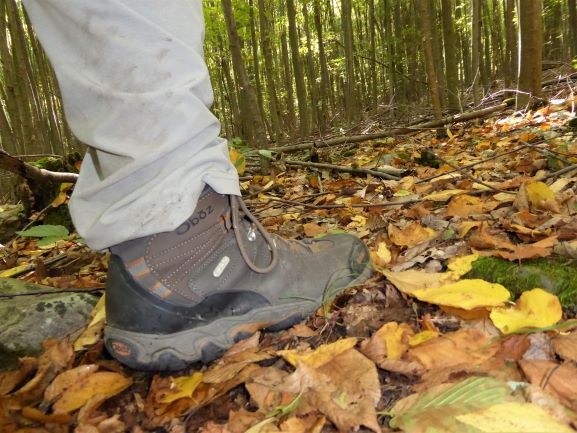
Contrary to popular belief, leather uppers are also breathable
* Since GORE-TEX is guaranteed for life, GORE won't provide waterproof membranes to any company until their boots/shoes test at or above GORE's required specs. Based on this testing, GORE may require specific design or materials changes to a boot or shoe before sourcing GTX membranes (and then re-testing the GTX boot/shoe for quality control).
Socks and breathability
Socks also impact breathability. In my experience, my choice of socks actually matters more than my choice between waterproof and non-waterproof footwear when it comes to moderating my feet's moisture and temperature.
Cotton socks, for example, absorb a ton of sweat and water—which not only feels gross and encourages blisters, but also reduces breathability. Merino blend or moisture-wicking synthetic socks, on the other hand, support breathablity by increasing evaporation.
Sock weight also makes a difference. In my experience, switching from a midweight to lightweight merino-blend sock has more of an effect on my feet than switching from waterproof or non-waterproof footwear. I'll almost always wear lightweight merino blend socks in warm weather and either lightweight or midweight merino wool socks in winter to moderate the moisture and temperature around my hiking feet.
Are waterproof hiking boots less breathable than non-waterproof?
Waterproof hiking boots are usually (but not always) less breathable than their non-waterproof counterparts. This has more to do with the added lining, backing, and adhesives than the waterproof membrane itself.
Honestly, the average day hiker probably doesn't hike fast enough or far enough to notice this difference in nice weather. If I'm only hiking 6-7 miles, for example, I consciously need to focus on my feet (instead of my hike) to notice they may be slightly (maybe 10%) warmer or damper in waterproof footwear. My socks will be damp in either waterproof or non-waterproof footwear.
When I ratchet up my day hikes to 12-18 miles, my feet may generate more heat and moisture vapor than my waterproof hiking boots can release. That's even more true of 15-20 mile backpacking days, where the added weight burns even more calories (heat).
In these use cases, long-distance day hikers and backpackers may prefer more ventilated and quick-drying trail running shoes to keep their feet cooler, trap less liquid, and speed up drying times. That being said, my non-waterproof trail running shoes will still be damp the morning after a hard day of backpacking—just slightly drier than my waterproof hiking boots.
The difference in breathability is more noticeable in winter—when my feet will be colder in non-waterproof footwear.
conclusion
Waterproof hiking boots aren't perfect. Thru-hikers, backpacking guides, and hardcore day hikers may have legitimate concerns about waterproofing or breathability coming up short—especially on all-day hikes in hot and humid weather. For them, non-waterproof trail running shoes may be the lesser of two evils.
That being said, waterproof hiking boots often work well for the average hiker. Most hikers are most active in nice weather and don't hike fast enough or far enough to have issues with the waterproof-breathable membranes failing them.
That being said, waterproof membranes aren't created equally. Hiking boots and shoes with GORE-TEX or eVent membranes generally will be more durable and breathable than waterproof hiking boots and hiking shoes that use brands' own proprietary membranes. Here are Hiking Feet's recommendations for the best waterproof hiking boots.
The choice is up to you—hike your own hike!
My hope, though, is that this post has debunked some common myths and misunderstandings about waterproofing and (especially) breathability to help you figure out what makes the most sense for where you hike, when you hike, and how you hike. As with most outdoor gear decisions, your best choice boils down to your body and the specific kinds of hiking you do.
FAQs
Yes, waterproof hiking boots have membranes or laminates that seal out moderate to heavy moisture, and GORE-TEX waterproofing is guaranteed for life. Brands based within the European Union can't be called "waterproof" without hydrostatic head tests of at least 5,000mm (i.e. their membranes can hold back more than 15 feet of water for 24 hours without leaking).
The texts in our landing pages can help you in creating good copy. And don't worry about it too much. The only way to get better at copywriting is to write more copy. So, get writing.
Waterproof hiking boots usually (but not always) run warmer than non-waterproof foowear due to added layers and adhesives. This can be a plus in cold environments and a minus in hot environments. That being said, many people don't hike fast enough or far enough to notice this difference in more moderate temperatures.
It's a waterproof membrane or laminate that makes a hiking boot "waterproof"—not a spray. However, the durable water repellent (DWR) coating on hiking boots needs to be kept clean and refreshed with a DWR spray whenever water stops beading up on the outside of the boot. That may be once a season—or once a month—depending on how much you hike and how well you take care of your boots and shoes.
GORE-TEX waterproofing is guaranteed for life. Proprietary waterproof membranes aren't quite as durable but may last as long as the rest of your boots or shoes if you don't damage them by exposing them to sediments, petroleum products, or sprays that can clog or compromise the waterproof membrane.
GORE-TEX remains the industry standard for waterproofing with durable membranes that are guaranteed for life with hydrostatic head ratings that are more than 5 times higher than the European Union's standard for "very waterproof" gear and apparel. Here are Hiking Feet's recommendations for the best waterproof hiking boots.
Contrary to popular belief, breathability does not refer to air flowing through porous materials. That's "air permeability"—not breathability, which refers to evaporative transfer, or "moisture vapor permeability." Most waterproof membranes ARE breathable (i.e. transmit evaporated moisture vapor) but NOT air permeable. For waterproof footwear that is not only breathable but also air permeable, hikers should buy boots/shoes with eVent waterproofing or FUTURELIGHT from The North Face.
